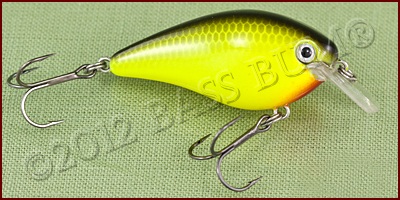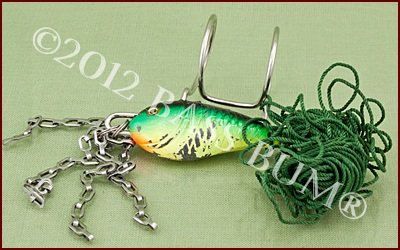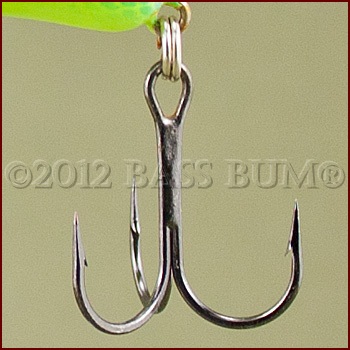Crankbait Fishing
Guess What? Most Of Us Do Our Crankbait Fishing Wrong!

 Strike King Series 1 Crankbait - Dives 2-5 Feet- Sexy Shad
Strike King Series 1 Crankbait - Dives 2-5 Feet- Sexy ShadCrankbait Fishing? Are We Talking Crankbait, Jerkbait Or Slashbait?
If we're crankbait fishing what exactly are we talking about? Here we're talking about lures that:
- Are hardbaits, made of wood or plastic
- In most instances have a "lip" sticking out the nose which makes it dive
- Are what could be clearly referred to as "round" bodied in shape
- Have two treble hooks attached, one under the belly, the other straight out its butt
The crankbaits we're talking about here are the "shad" shaped lures. Those which are basically short and fat when viewed from the side, as opposed to the long thin profile of a minnow lure or jerkbait.

When Crankbait Fishing, Hang-Ups Happen!
First thing you must overcome when fishing crankbait lures is the fear of "hanging up". Why? Because crankbait fishing is a contact sport! To be effective you must run them into something!
It's natural law, ordained by the "God of Aggravation", that treble hooks on hardbaits will impale themselves into anything within a foot of them. Just trying to get them untangled in your tackle box can drive you to drink. If they snag your clothes or the boat carpet you will be on the verge of insanity by the time you get them free.
So we're all programmed to fear anything but open water when crankbait fishing. Reality is that if you avoid bumping cover or structure with these type hardbaits you will also avoid catching bass. There a few exceptions, which we'll cover later.
So....
- 1) you must learn how to run a crankbait into cover and
structure without getting hung up and
- (2) also learn how to free your
crankbaits when they do hang up, because they inevitably will.
Oh, and by the way. You need to accept the fact
that you will lose some crankbaits.
SUGGESTION: Get yourself a good "lure retriever" and keep it
handy when you're crankbait fishing. They will help greatly in
eliminating the stress of hang-ups. Plus, they will pay for themselves
in rescued crankbait lures.
How Do You Avoid Hang Ups?
It's really impossible to avoid them. It's the nature of crankbait fishing. However, if you fish crankbait lures enough you will develop a "sense of feel" for them. They will each have a specific cadence, an identifiable wiggle or wobble that you'll recognize through your grip on the rod.
Learning The Feel Of A Crankbait Lure
Crankbaits travel through the water with their lips angled down and their tail ends up. The line and the lure's lip run interference for the two treble hooks. Additionally, the force of water swiping past the crankbait body pushes the treble hooks backwards. This positions them out of the way of oncoming cover and insures the line and lip are what first collides with cover obstructions. This feature, combined with a "learned" sense of feel is what makes them more snag resistant than you might think.
Your line is "out in front" of the crankbait body with the lip immediately behind. So the line is first to contact an object. The treble hooks aren't going to "drop" until the lure stops.
The line, then the hook bumps cover first. When it does you will notice a change in the lure's rhythm. This is when you 'back off', for an instant, giving your plug a a few inches slack letting it float away from the object. Then you resume your retrieve moving your lure past it. This works especially well with a balsa crankbait. Alternate letting your lure "deadstick" for a few seconds before starting your retrieve. Strikes often occur when the lure is sitting still.
Lure Retriever - Lead Fish Head and String

Crap! I'm Hung!
Now what do you do? Well, I usually reach for one of my my trusty lure retrievers, lure knockers, whatever you want to call them. I have two of them. What's that tell you? Anyway, they work 90% of the time, are quick and get me on my way.
What if you don't have a retriever? Don't try to "horse" it loose. You will only dig the hook point in deeper and if it passes the barb, forget about it. Do the following.
Reposition your boat so you will be pulling your line from the opposite direction. If it fails to release tighten your line and pluck it like a banjo string. The vibration will sometimes free it.
Now, there is another variation of this technique. It's referred to as the "bow and arrow" technique. It is done as follows:
- Place your rod butt on the boat deck between your feet.
- The rod should be vertical pointing to the sky.
- Grab your line about a foot from the rod tip.
- With your other hand grab the line three feet farther down.
- Now imagine your upper hand and the snagged lure are the two tips of this imaginary bow.
- With your free hand pull back on the middle of the line all the way back to your body. Think deer hunting.
- After reaching your max pull-back distance, release it.
Repeat as necessary until your crankbait comes free. If not and frustration overcomes you, curse, spit and break your line.

Ptooey! Out Goes Your Crankait Lure
Herein Lies The Essence Of Crankbait Fishing.
How will you know when a bass takes your lure? When a bass takes a crankbait lure the lure's action stops. No more wiggle or wobble. There, that is your indication to set the hook!
Got him! Right? Not so fast Sparky. It's estimated from studies that as many as half the strikes on crankbaits are never felt by the angler. Most strikes take place from behind and often at that moment when you stop your retrieve after contacting an object, when there is a 'momentary' end to the lure's action anyway.
So, you've stopped your retrieve thereby stopping the lure's action. At the same time old bucketmouth decides it's time to grab this meal before it gets away. He/she opens its mouth, sucks in your lure, decides it's much to hard and tasteless to be a soft, juicy baitfish and 'ptooey', right back out it goes. How long does this take? Only a few milliseconds! Literally faster than the blink of a human eye.
Treble Hook on a KVD 6Xd Crankbait

Why don't the treble hooks do their thing? After all, your crankbait lures are constantly snagging your fingers, clothes, the boat carpet or the anchor rope. Why not the inside of the bass' mouth? Because a bass has "distance receptors" in its sense of taste, just like its sense of smell. It does not have to physically touch what it takes into its mouth to taste it. It would be like you having the ability to taste each item in a buffet line before telling the server what items you want dished up.
At least half of bass strikes occur with them taking a crankbait from behind. A bass can suck your plastic or balsa crankbait into its mouth and as it floats in its mouth full of water for just a micro second , determine if it wants to eat it or not, then spit it out, all in an instant. No treble hook touches the bass' lips.
What does all this mean? It means when you're crankbait fishing you must know the feel of your crankbait, concentrate and set the hook anytime you sense the slightest change in its action.
It's A Shark!
There are times of course when your crankbait gets hit so hard you think 'Jaws' himself must have made his way to your lake. We all recognize these type strikes. They practically pull the rod from your hands. If all your bass caught on crankbaits are a result of this type strike, you're probably missing that many more you never feel.
Learn your "crankbait's feel" and you will catch more bass on them.
Return To Crankbaits From Crankbait Fishing
